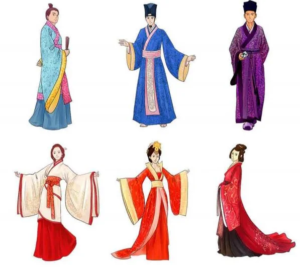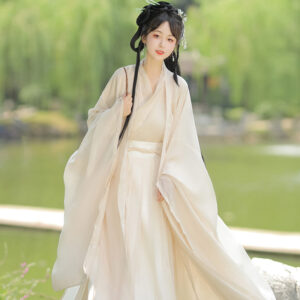

There were several forbidden colors and designs in ancient Hanfu, particularly due to the strict regulations imposed by different dynasties to maintain social order and hierarchical distinctions. These regulations were deeply influenced by Confucian ideals of propriety and the need to visibly differentiate between the emperor, the nobility, officials, and commoners. Here’s an in-depth look at forbidden colors and designs in ancient Hanfu:
1. The Imperial Color: Yellow
Yellow, especially bright yellow (referred to as “Minghuang” or 明黄), was the most sacred and strictly regulated color in ancient China. It was reserved exclusively for the emperor and members of the imperial family. The color symbolized the emperor’s divine connection to Heaven, as well as his supreme authority over the empire. In the Five Elements theory (Wu Xing), yellow was associated with the Earth, the central element, which further reinforced the emperor’s role as the stabilizing force of the realm.
- Who Could Wear Yellow: Only the emperor was allowed to wear bright yellow in formal settings, particularly in ceremonial robes such as the Dragon Robe (龙袍, Longpao). Occasionally, high-ranking members of the imperial family, such as the crown prince or the empress, were permitted to wear variations of yellow, but the shades had to be softer or less saturated to differentiate them from the emperor.
- Forbidden Use of Yellow: Commoners and officials were strictly prohibited from wearing yellow. Violating this rule, especially in the capital or at court, could result in severe punishment, as it was seen as an act of rebellion or disrespect towards the emperor.
2. Five-Clawed Dragons (Wulong)
The five-clawed dragon design was another motif reserved exclusively for the emperor. Dragons were powerful symbols of imperial authority, and the five-clawed dragon (五爪龙) was the most prestigious form of the dragon, representing the emperor’s divine right to rule. The motif was most commonly seen on the emperor’s dragon robes and other imperial regalia.
- Who Could Wear Dragons: While the emperor’s dragon robes featured five-clawed dragons, princes, and high-ranking nobles could wear robes adorned with four-clawed dragons, known as Mang (蟒). Lower-ranking officials were permitted to wear robes with three-clawed dragons or dragon-like serpentine motifs, but they were strictly forbidden from using the five-clawed version.
- Punishment for Using Forbidden Dragon Designs: Any commoner or official who dared to wear garments featuring the five-clawed dragon would be accused of usurping the emperor’s authority, which was considered treasonous and could result in severe penalties, including execution.
3. Purple: A Royal Privilege
Purple, especially deep purple (referred to as Zijin, 紫禁), was another restricted color that was often associated with high-ranking nobility and the royal family. Purple dye was expensive and difficult to produce, which made it a luxurious color that symbolized wealth and power. In many periods, it was used as a color for high-ranking officials, particularly during the Ming and Qing Dynasties, when purple robes were reserved for those of significant status.
- Who Could Wear Purple: High-ranking officials, especially those in the imperial court, were sometimes allowed to wear purple. It was considered an honor to be bestowed a purple robe, symbolizing trust and favor from the emperor.
- Forbidden Use of Purple: Commoners and lower-ranking officials were not allowed to wear purple, as it was seen as a color of authority and prestige. Violating this rule could be interpreted as an attempt to claim status beyond one’s rank, which could lead to punishment.
4. Bright Red: A Restricted Color
While red was generally a color of joy, celebration, and luck in Chinese culture, bright red (大红, Dahong) was often restricted for use by high-ranking officials and nobility, particularly during certain dynasties.
- Who Could Wear Bright Red: Bright red was commonly used for imperial ceremonies and important state functions. High-ranking officials and members of the royal family could wear red during formal occasions, such as weddings or rituals. Red also symbolized the South in the Five Elements theory, associated with fire and authority.
- Forbidden Use of Red by Commoners: Although commoners could wear muted shades of red in everyday life, bright red was generally reserved for nobility and officials, especially in formal settings. Commoners were forbidden from wearing bright red during official functions or ceremonies unless they were given special permission.
5. Gold Embroidery and Designs
Gold embroidery was another restricted feature in Hanfu, reserved primarily for the emperor, the royal family, and very high-ranking officials. The use of gold in clothing was a sign of immense wealth and power, as gold thread was extremely costly and difficult to produce.
- Who Could Wear Gold Embroidery: The emperor’s robes often featured intricate gold embroidery, particularly in the form of dragons, clouds, and other auspicious symbols. Princes and high-ranking nobles could wear garments with some gold embellishments, but the designs were less intricate and grand than those of the emperor.
- Forbidden Use of Gold by Commoners: Commoners and lower-ranking officials were prohibited from using gold in their clothing. The use of gold embroidery by someone outside the royal family was seen as an overreach of status and was punishable.
6. Phoenix Motifs for the Empress
While the dragon was the exclusive symbol of the emperor, the phoenix (凤, Feng) was reserved for the empress. The phoenix represented feminine power, grace, and virtue, and was often used on the empress’s ceremonial robes and accessories. It was typically paired with motifs like peonies and clouds, further signifying beauty and prosperity.
- Who Could Use Phoenix Designs: The empress, imperial concubines, and other high-ranking women of the royal family were the only ones permitted to use phoenix motifs. These designs were often seen on ceremonial dresses, headpieces (such as the Fengguan, 凤冠), and other court regalia.
- Forbidden Use of Phoenix Designs by Commoners: Women outside the royal family were not allowed to wear phoenix motifs. Doing so would be viewed as a serious breach of etiquette and an attempt to usurp the empress’s symbolic power.
7. Specific Colors and Designs for Officials
Each rank of official during many dynasties had specific color and design restrictions. The Ming and Qing Dynasties were particularly strict about what officials could wear, with rank badges (补子, Buzi) playing a major role in identifying status. These badges featured specific animals or birds that represented different official ranks.
- Color Restrictions for Officials: During the Ming Dynasty, for example, first-rank officials wore robes with deep red or purple tones, while lower-ranking officials wore blue, green, or black. Each official rank had its prescribed colors and designs, which were strictly enforced.
- Forbidden Use of High-Ranking Designs: Lower-ranking officials and commoners were not allowed to wear the colors or patterns designated for higher ranks. Wearing a robe with a higher rank’s design could result in demotion, fines, or even exile.
8. Peasant Clothing Restrictions
Commoners, particularly peasants and farmers, were restricted to wearing plain, simple garments made of cheaper materials such as cotton, hemp, or wool. These clothes were usually in natural, muted colors like grey, brown, or dark blue.
- Forbidden Bright Colors for Peasants: Peasants were not allowed to wear bright colors, particularly bright red, purple, or yellow, as these were considered luxurious and inappropriate for their social class. Clothing laws often dictated that peasants should wear neutral, subdued colors that reflected their humble status.
Summary: The Symbolism and Social Hierarchy in Hanfu Colors and Designs
In ancient China, clothing was not merely a matter of fashion; it was deeply symbolic and played a critical role in maintaining social hierarchy. Forbidden colors and designs in Hanfu were used to differentiate between the emperor, nobles, officials, and commoners, reinforcing Confucian values of order and propriety. The strict regulations surrounding clothing colors, patterns, and materials emphasized one’s place in society, and violating these rules was seen as a serious offense, often resulting in harsh punishment. The rich cultural heritage of Hanfu, with its intricate rules and symbolism, continues to influence modern Chinese fashion and the revival of traditional Han clothing today.
Share this post
Recent Posts


What were the key features of Hanfu during the Tang Dynasty?

How did Hanfu styles vary during different Chinese dynasties?

What accessories are typically worn with Hanfu?

How do you choose the right Hanfu for different seasons?

Newsletter
Popular Categories
Related Post
Sed aliquam, tortor et sodales malesuada, lorem leo luctus tellus, quis interdum eros nibh in nunc. Cras dignissim malesuada, lorem leo luctus

What are the winter hanfu called?

What were the key features of Hanfu during the Tang Dynasty?

How did Hanfu styles vary during different Chinese dynasties?


